Fatimid Caliphate
The Fatimid Caliphate was an Ismaili Shia caliphate that spanned a large area of North Africa, from the Red Sea in the east to the Atlantic Ocean in the west. The dynasty of Arab origin[4] ruled across the Mediterranean coast of Africa and ultimately made Egypt the center of the caliphate. At its height the caliphate included in addition to Egypt varying areas of the Maghreb, Sudan, Sicily, the Levant, and Hijaz.
Fatimid Caliphate الخلافة الفاطمية Al-Khilafah al-Fāṭimīyah | |||||||||||||||||||||||||||
|---|---|---|---|---|---|---|---|---|---|---|---|---|---|---|---|---|---|---|---|---|---|---|---|---|---|---|---|
| 909–1171 | |||||||||||||||||||||||||||
 | |||||||||||||||||||||||||||
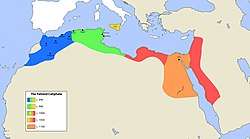 Evolution of the Fatimid state | |||||||||||||||||||||||||||
| Capital |
| ||||||||||||||||||||||||||
| Common languages |
| ||||||||||||||||||||||||||
| Religion | Islam (Isma'ili Shia) | ||||||||||||||||||||||||||
| Government | Caliphate | ||||||||||||||||||||||||||
| Caliph | |||||||||||||||||||||||||||
• 909–934 (first) | Abdullah al-Mahdi Billah | ||||||||||||||||||||||||||
• 1160–1171 (last) | al-Adid | ||||||||||||||||||||||||||
| Historical era | Early Middle Ages | ||||||||||||||||||||||||||
• Overthrow of the Aghlabids | 5 January 909 | ||||||||||||||||||||||||||
• Fatimid conquest of Egypt and foundation of Cairo | 969 | ||||||||||||||||||||||||||
| 17 September 1171 | |||||||||||||||||||||||||||
| Area | |||||||||||||||||||||||||||
| 969[2][3] | 4,100,000 km2 (1,600,000 sq mi) | ||||||||||||||||||||||||||
| Currency | Dinar | ||||||||||||||||||||||||||
| |||||||||||||||||||||||||||
| Caliphate خِلافة |
|---|
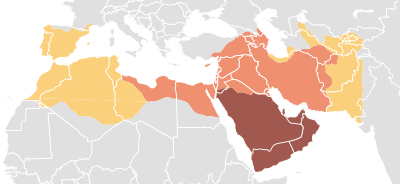 |
|
Main caliphates |
|
Parallel caliphates |
|
|
| Historical Arab states and dynasties | ||||||||||||||||||||||||||||||||||||||||||||||||||||||||||
|---|---|---|---|---|---|---|---|---|---|---|---|---|---|---|---|---|---|---|---|---|---|---|---|---|---|---|---|---|---|---|---|---|---|---|---|---|---|---|---|---|---|---|---|---|---|---|---|---|---|---|---|---|---|---|---|---|---|---|
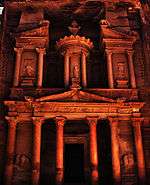 | ||||||||||||||||||||||||||||||||||||||||||||||||||||||||||
|
Ancient Arab States
|
||||||||||||||||||||||||||||||||||||||||||||||||||||||||||
|
Arab Empires
|
||||||||||||||||||||||||||||||||||||||||||||||||||||||||||
|
Eastern Dynasties
|
||||||||||||||||||||||||||||||||||||||||||||||||||||||||||
|
Western Dynasties
|
||||||||||||||||||||||||||||||||||||||||||||||||||||||||||
|
Arabian Peninsula
|
||||||||||||||||||||||||||||||||||||||||||||||||||||||||||
|
East Africa
|
||||||||||||||||||||||||||||||||||||||||||||||||||||||||||
|
Current monarchies
|
||||||||||||||||||||||||||||||||||||||||||||||||||||||||||
Part of a series on the |
||||||||||||||||||
|---|---|---|---|---|---|---|---|---|---|---|---|---|---|---|---|---|---|---|
| History of Egypt | ||||||||||||||||||
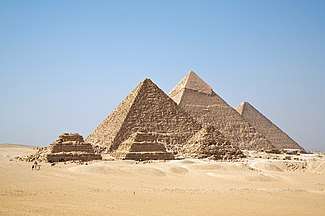 | ||||||||||||||||||
|
||||||||||||||||||
|
||||||||||||||||||
|
||||||||||||||||||
|
||||||||||||||||||
|
||||||||||||||||||
|
||||||||||||||||||
|
| ||||||||||||||||||
The Fatimids (Arabic: الفاطميون, romanized: al-Fāṭimīyūn) claimed descent from Fatimah, the daughter of the prophet Muhammad. The Fatimid state took shape among the Kutama, Berbers located in the west of the North African littoral (in Kabylie, Algeria). In 909 using the military might of the Kutama, they conquered Raqqada, the Aghlabid capital. In 921, the Fatimids established the Tunisian city of Mahdia as their new capital. In 948 they shifted their capital to al-Mansuriyya, near Kairouan in Tunisia. In 969, they conquered Egypt, and in 973, they established Cairo as the capital of their caliphate. Egypt became the political, cultural, and religious centre of their empire, which developed a new and indigenous Arabic culture.[5]
The ruling class belonged to the Ismai'li branch of Shi'a Islam, as did the leaders of the dynasty. The existence of the caliphate marked the only time the descendants of Ali and Fatimah were united to any degree (except for the final period of the Rashidun Caliphate under Ali himself from 656 to 661) and the name "Fatimid" refers to Fatimah. The different term Fatimi (or “Fatimite”) by orientalist authors is sometimes used to refer to the caliphate's subjects.
After the initial conquests, the caliphate often allowed a degree of religious tolerance towards non-Shia sects of Islam, as well as to Jews, Maltese Christians, and Copts.[6] However, its leaders made little headway in persuading the Egyptian population to adopt its religious beliefs.[7]
During the late eleventh and twelfth centuries the Fatimid caliphate declined rapidly, and in 1171 Saladin invaded its territory. He founded the Ayyubid dynasty and incorporated the Fatimid state into the Abbasid Caliphate.[8]
History
Origins
The Fatimid dynasty came to power as the leaders of Isma'ilism, a revolutionary Shi'a movement "which was at the same time political and religious, philosophical and social", and which originally proclaimed nothing less than the arrival of an Islamic messiah.[9] The origins of that movement, and of the dynasty itself, are obscure prior to the late 9th century.[9]
Early Shi'ism and the roots of Isma'ilism
The Shi'a opposed the Umayyad and Abbasid caliphates, whom they considered usurpers. Instead, they believed in the exclusive right of the descendants of Ali through Muhammad's daughter, Fatima, to lead the Muslim community. This manifested itself in a line of imams, descendants of Ali via al-Husayn, whom their followers considered as the true representatives of God on earth.[10] At the same time, there was a widespread messianic tradition in Islam concerning the appearance of a mahdī ("the Rightly Guided One") or qāʾīm ("He Who Arises"), who would restore true Islamic government and justice and usher in the end times. This figure was widely expected—not just among the Shi'a—to be a descendant of Ali.[11] Among Shi'a, however, this belief became a core tenet of their faith, and was applied to several Shi'a leaders who were killed or died; their followers believed that they had gone into "occultation" (ghayba) and would return (or be resurrected) at the appointed time.[12]
These traditions manifested themselves in the succession of the sixth imam, Ja'far al-Sadiq. Al-Sadiq had appointed his son Isma'il ibn Ja'far as his successor, but Isma'il died before his father, and when al-Sadiq himself died in 765, the succession was left open. Most of his followers followed al-Sadiq's son Musa al-Kazim down to a twelfth and final imam who supposedly went into occultation in 874 and would one day return as the mahdī. This branch is hence known as the "Twelvers".[13][14] Others followed other sons, or even refused to believe that al-Sadiq had died, and expected his return as the mahdī.[15] Another branch believed that Ja'far was followed by a seventh imam, who also had gone into occultation and would one day return; hence this party is known as the "Seveners". The exact identity of that seventh imam was disputed, but by the late 9th century had commonly been identified with Muhammad, son of Isma'il and grandson of al-Sadiq. From Muhammad's father, Isma'il, the sect, which gave rise to the Fatimids, receives its name of "Isma'ili".[13][16][17] Neither Isma'il's nor Muhammad's lives are well known, and after Muhammad's death during the reign of Harun al-Rashid (r. 786–809), the history of the early Isma'ili movement becomes obscure.[18]
The secret network
While the awaited mahdī Muhammad ibn Isma'il remained hidden, however, he would need to be represented by agents, who would gather the faithful, spread the word (daʿwa, "invitation, calling"), and prepare his return. The head of this secret network was the living proof of the imam's existence, or "seal" (ḥujja).[19] It is this role that the ancestors of the Fatimids are first documented. The first known ḥujja was a certain Abdallah al-Akbar ("Abdallah the Elder"), a wealthy merchant from Khuzestan, who established himself at the small town of Salamiya on the western edge of the Syrian Desert.[20] Salamiya became the centre of the Isma'ili daʿwa, with Abdallah al-Akbar being succeeded by his son and grandson as the secret "grand masters" of the movement.[21][22]
In the last third of the 9th century, the Isma'ili daʿwa spread widely, profiting from the collapse of Abbasid power in the Anarchy at Samarra and the subsequent Zanj Revolt, as well as from dissatisfaction among Twelver adherents with the political quietism of their leadership and the recent disappearance of the twelfth imam.[23] Missionaries (dā'īs) such as Hamdan Qarmat and Ibn Hawshab spread the network of agents to the area round Kufa in the late 870s, and from there to Yemen (882) and thence India (884), Bahrayn (899), Persia, and the Maghreb (893).[24][25][26]
The Qarmatian schism and its aftermath
In 899, Abdallah al-Akbar's great-grandson, Abdallah,[lower-alpha 1] became the new head of the movement, and introduced a radical change in the doctrine: no longer was he and his forebears merely the stewards for Muhammad ibn Isma'il, but they were declared to be the rightful imams, and Abdallah himself was the awaited mahdī.[29] Various genealogies were later put forth by the Fatimids to justify this claim by proving their descent from Isma'il ibn Ja'far, but even in pro-Isma'ili sources, the succession and names of imams differ, while Sunni and Twelver sources of course reject any Fatimid descent from the Alids altogether and consider them impostors.[30][31] Abdallah's claim caused a rift in the Isma'ili movement, as Hamdan Qarmat and other leaders denounced this change and held onto the original doctrine, becoming known as the "Qarmatians", while other communities remained loyal to Salamiya.[24][28] Shortly after, in 902–903, pro-Fatimid loyalists began a great uprising in Syria. The large-scale Abbasid reaction it precipitated and the attention it brought on him, forced Abdallah to abandon Salamiya for Palestine, Egypt, and finally for the Maghreb, where the dā'ī Abu Abdallah al-Shi'i had made great headway in converting the Kutama Berbers to the Isma'ili cause. Unable to join his dā'ī directly, Ubayd Allah instead settled at Sijilmasa.[27][32]
Establishment of the Fatimid Caliphate
Beginning in 902, the dā'ī Abu Abdallah al-Shi'i had openly challenged the Abbasids' represnetatives in the eastern Maghreb (Ifriqiya.), the Aghlabid dynasty. After a succession of victories, the last Aghlabid emir left the country, and the dā'ī's Kutama troops entered the palace city of Raqqada on 25 March 909.[28] Abu Abdallah established a new, Shi'a regime, on behalf of his absent, and for the moment unnamed, master. He then led his army west to Sijilmasa, whence he led Abdallah in triumph to Raqqada, which he entered on 15 January 910. There Abdallah publicly proclaimed himself as caliph with the regnal name of al-Mahdī, and presented his son and heir, with the regnal name of al-Qa'im.[27][28] Al-Mahdi quickly fell out with Abu Abdallah: not only was the dā'ī over-powerful, but he demanded proof that the new caliph was the true mahdī. The elimination of Abu Abdallah al-Shi'i and his brother led to an uprising among the Kutama, led by a child-mahdī, which was suppressed. At the same time, al-Mahdi repudiated the millenarian hopes of his followers and curtailed their antinomian tendencies.[27][28]
The new regime regarded its presence in Ifriqiya as only temporary: the real target was Baghdad, the capital of the Fatimids' Abbasid rivals.[27] The ambition to carry the revolution eastward had to be postponed after the failure of two successive invasions of Egypt, led by al-Qa'im, in 914–915 and 919–921.[28] In addition, the Fatimid regime was as yet unstable. The local population were mostly adherents of Maliki Sunnism and various Kharijite sects such as Ibadism,[27] so that the real power base of Fatimids in Ifriqiya was quite narrow, resting on the Kutama soldiery, later extended by the Sanhaja Berber tribes as well. The historian Heinz Halm describes the early Fatimid state as being, in essence, "a hegemony of the Kutama and Sanhaja Berbers over the eastern and central Maghrib".[28] In 916–921, al-Mahdi built himself a new, fortified palace city on the Mediterranean shore, al-Mahdiyya,[28] removed from the Sunni stronghold of Kairouan.[27]
The Fatimids also inherited the Aghlabid province of Sicily, which the Aghlabids had gradually conquered from the Byzantine Empire starting in 827. This process was still incomplete, however: the Byzantines still held territories in the northeast of Sicily, as well as in southern Italy.[33] This ongoing confrontation with the traditional foe of the Islamic world provided the Fatimids with a prime opportunity for propaganda, in a setting where geography gave them the advantage.[34] Sicily itself proved troublesome, and only after a rebellion under Ibn Qurhub was subdued, was Fatimid authority on the island consolidated.[35] The Fatimids also faced difficulties in establishing control over the western Maghreb, as they were confronted by rival dynasties hostile to the Fatimids' pretensions, including the powerful Umayyads of Spain.[27] In 911, Tahert, which had been briefly captured by Abu Abdallah al-Shi'i in 909, had to be retaken by the Fatimid general Masala ibn Habus. He went on to capture Fez in 920, expelling the local Idrisid dynasty, and Sijilmasa in 921.[36] Masala's successor, Musa ibn Abi'l-Afiya, captured Fez from the Idrisids again, but in 932 defected to the Umayyads, taking the western Maghreb with him.[35] All this warfare necessitated the maintenance of a strong army, and a capable fleet as well.[27] Nevertheless, by the time of al-Mahdi's death in 934, the Fatimid Caliphate "had become a great power in the Mediterranean".[28]
The reign of the second Fatimid imam-caliph, al-Qa'im, was dominated by the Kharijite rebellion of Abu Yazid. Starting in 943/4 among the Zenata Berbers, the uprising spread through Ifriqiya, taking Kairouan and blockading al-Qa'im at al-Mahdiyya, which was besieged in January–September 945. Al-Qa'im died during the siege, but this was kept secret by his son and successor, Isma'il, until he had defeated Abu Yazid; he then announced his father's death and proclaimed himself imam and caliph as al-Mansur.[27][28] While al-Mansur was campaigning to suppress the last remnants of the revolt, a new palace city was being constructed for him south of Kairouan. It was named al-Mansuriyya, and became the new seat of the caliphate.[28]
In 969 the Fatimid general Jawhar the Sicilian conquered Egypt, where he built near Fusṭāt a new palace city which he also called al-Manṣūriyya. Under Al-Mu'izz li-Din Allah the Fatimids conquered the Ikhshidid Wilayah (see Fatimid Egypt), founding a new capital at al-Qāhira (Cairo) in 969.[37] The name al-Qāhirah (Arabic: القاهرة), meaning "the Vanquisher" or "the Conqueror", referenced the planet Mars, "The Subduer",[38] rising in the sky at the time when the construction of the city started. Cairo was intended as a royal enclosure for the Fatimid caliph and his army—the actual administrative and economic capitals of Egypt were cities such as Fustat until 1169. After Egypt, the Fatimids continued to conquer the surrounding areas until they ruled from Tunisia to Syria, as well as Sicily.
Under the Fatimids, Egypt became the centre of an empire that included at its peak parts of North Africa, Sicily, Jordan, the Levant, the Red Sea coast of Africa, Tihamah, Hejaz, Yemen, with its most remote territorial reach being Multan (in modern-day Pakistan).[39][40][41] Egypt flourished, and the Fatimids developed an extensive trade network both in the Mediterranean and in the Indian Ocean. Their trade and diplomatic ties, extending all the way to China under the Song Dynasty (r. 960–1279), eventually determined the economic course of Egypt during the High Middle Ages. The Fatimid focus on agriculture further increased their riches and allowed the dynasty and the Egyptians to flourish under the Fatimid rule. The use of cash crops and the propagation of the flax trade allowed Fatimids to import other items from various parts of the world.[42]
Decline
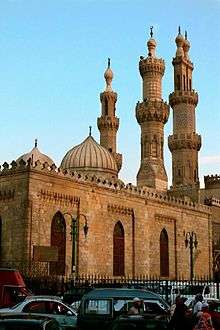
.jpg)
While the ethnic-based army was generally successful on the battlefield, it began to have negative effects on Fatimid internal politics. Traditionally the Berber element of the army had the strongest sway over political affairs, but as the Turkish element grew more powerful, it began to challenge this, and by 1020 serious riots had begun to break out among the Black African troops who were fighting back against a Berber-Turk Alliance.
By the 1060s, the tentative balance between the different ethnic groups within the Fatimid army collapsed as Egypt suffered an extended period of drought and famine. Declining resources accelerated the problems among the different ethnic factions, and outright civil war began, primarily between the Turks under Nasir al-Dawla ibn Hamdan and Black African troops, while the Berbers shifted alliance between the two sides.[43] The Turkish forces of the Fatimid army seized most of Cairo and held the city and Caliph at ransom, while the Berber troops and remaining Sudanese forces roamed the other parts of Egypt.
By 1072, in a desperate attempt to save Egypt, the Fatimid Caliph Abū Tamīm Ma'ad al-Mustansir Billah recalled general Badr al-Jamali, who was at the time the governor of Acre. Badr al-Jamali led his troops into Egypt and was able to successfully suppress the different groups of the rebelling armies, largely purging the Turks in the process. Although the Caliphate was saved from immediate destruction, the decade long rebellion devastated Egypt and it was never able to regain much power. As a result, Badr al-Jamali was also made the vizier of the Fatimid caliph, becoming one of the first military viziers ("Amir al Juyush", Arabic: امير الجيوش, Commander of Forces of the Fatimids) who would dominate late Fatimid politics. Al-Jam`e Al-Juyushi (Arabic: الجامع الجيوشي, The Mosque of the Armies), or Juyushi Mosque, was built by Badr al-Jamali. The mosque was completed in 478 H/1085 AD under the patronage of then Caliph and Imam Ma'ad al-Mustansir Billah. It was built on an end of the Mokattam Hills, ensuring a view of the Cairo city.[44] This Mosque/mashhad was also known as a victory monument commemorating vizier Badr's restoration of order for the Imam Mustansir.[45] As the military viziers effectively became heads of state, the Caliph himself was reduced to the role of a figurehead. Badr al-Jamali's son, Al-Afdal Shahanshah, succeeded him in power as vizier.
In the 1040s, the Berber Zirids (governors of North Africa under the Fatimids) declared their independence from the Fatimids and their recognition of the Sunni Abbasid caliphs of Baghdad, which led the Fatimids to launch the devastating Banū Hilal invasions of North Africa. After about 1070, the Fatimid hold on the Levant coast and parts of Syria was challenged first by Turkic invasions, then the Crusades, so that Fatimid territory shrank until it consisted only of Egypt. The Fatimids gradually lost the Emirate of Sicily over thirty years to the Italo-Norman Roger I who was in total control of the entire island by 1091.
The reliance on the Iqta system also ate into Fatimid central authority, as more and more the military officers at the further ends of the empire became semi-independent.
After the decay of the Fatimid political system in the 1160s, the Zengid ruler Nūr ad-Dīn had his general, Shirkuh, seize Egypt from the vizier Shawar in 1169. Shirkuh died two months after taking power, and rule passed to his nephew, Saladin.[46] This began the Ayyubid Sultanate of Egypt and Syria.
Dynasty
Caliphs
- Abū Muḥammad 'Abdul-Lāh al-Mahdī bi'llāh (909–934) founder Fatimid dynasty
- Abū l-Qāsim Muḥammad al-Qā'im bi-Amr Allāh (934–946)
- Abū Ṭāhir Ismā'il al-Manṣūr bi-llāh (946–953)
- Abū Tamīm Ma'add al-Mu'izz li-Dīn Allāh (953–975) Egypt is conquered during his reign[47]
- Abū Manṣūr Nizār al-'Azīz bi-llāh (975–996)
- Abū 'Alī al-Manṣūr al-Ḥākim bi-Amr Allāh (996–1021) The Druze religion is founded during the lifetime of Al-Hakim bi-Amr Allah.
- Abū'l-Ḥasan 'Alī al-Ẓāhir li-I'zāz Dīn Allāh (1021–1036)
- Abū Tamīm Ma'add al-Mustanṣir bi-llāh (1036–1094) Quarrels over his succession led to the Nizari split.
- al-Musta'lī bi-llāh (1094–1101)
- Abū 'Alī Mansur al-Āmir bi-Aḥkām Allāh (1101–1130) The Fatimid rulers of Egypt after him are not recognized as Imams by Mustaali/Taiyabi Ismailis.
- 'Abd al-Majīd al-Ḥāfiẓ (1130–1149) The Hafizi sect is founded with Al-Hafiz as Imam.
- al-Ẓāfir (1149–1154)
- al-Fā'iz (1154–1160)
- al-'Āḍid (1160–1171)[48]
Consorts
Burial places
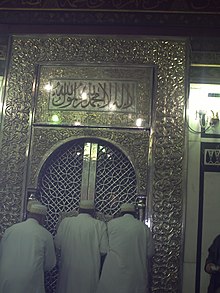
"Al-Mashhad al-Hussaini" (Masjid Imam Husain, Cairo) is the burial site of twelve Fatimid Imams: the 9th, Taqi Muhammad, through the 20th, Mansur al-Āmir. The site is also known as "Bāb Mukhallafāt al-Rasul" (door of remaining part of Rasul), where the Sacred Hair [50][51] of Muhammad is preserved.
Capital cities
Al-Mahdiyya, the first capital of the Fatimid dynasty, was established by its first caliph, ʿAbdullāh al-Mahdī (297–322 AH/909–934 CE) in 300 AH/912–913 CE. The caliph had been residing in nearby Raqqada but chose this new and more strategic location in which to establish his dynasty. The city of al-Mahdiyya is located on a narrow peninsula along the coast of the Mediterranean Sea, east of Kairouan and just south of the Gulf of Hammamet, in modern-day Tunisia. The primary concern in the city's construction and locale was defense. With its peninsular topography and the construction of a wall 8.3 m thick, the city became impenetrable by land. This strategic location, together with a navy that the Fatimids had inherited from the conquered Aghlabids, made the city of Al-Mahdiyya a strong military base where ʿAbdullāh al-Mahdī consolidated power and planted the seeds of the Fatimid caliphate for two generations. The city included two royal palaces – one for the caliph and one for his son and successor al-Qāʾim – as well as a mosque, many administrative buildings, and an arsenal.[52]
Al-Manṣūriyya was established between 334 and 336 AH (945 and 948 CE) by the third Fatimid caliph al-Manṣūr (334-41 AH/946-53 CE) in a settlement known as Ṣabra, located on the outskirts of Kairouan in modern-day Tunisia. The new capital was established in commemoration of the victory of al-Manṣūr over the Khārijite rebel Abū Yazīd at Ṣabra. Like Baghdad, the plan of the city of Al-Manṣūriyya is round, with the caliphal palace at its center. Due to a plentiful water source, the city grew and expanded a great deal under al-Manṣūr. Recent archaeological evidence suggests that there were more than 300 ḥammāms built during this period in the city as well as numerous palaces. When al-Manṣūr's successor, al-Muʿizz, moved the caliphate to Cairo, his deputy stayed behind as regent of al-Manṣūriyya and usurped power for himself, marking the end of the Fatimid reign in al-Manṣūriyya and the beginning of the city's ruin (spurred on by a violent revolt). The city remained downtrodden and more or less uninhabited for centuries afterward.[53]
Cairo was established by the fourth Fatimid caliph al-Muʿizz in 359 AH/970 CE and remained the capital of the Fatimid caliphate for the duration of the dynasty. Cairo can thus be considered the capital of Fatimid cultural production. Though the original Fatimid palace complex, including administrative buildings and royal residents, no longer exists, modern scholars can glean a good idea of the original structure based on the Mamluk-era account of al-Maqrīzī. Perhaps the most important of Fatimid monuments outside the palace complex is the mosque of al-Azhar (359-61 AH/970-72 CE) which still stands today, though little of the building is original to its first Fatimid construction. Likewise the important Fatimid mosque of al-Ḥākim, built from 380-403 AH/990-1012 CE under two Fatimid caliphs, has been rebuilt under subsequent dynasties. Cairo remained the capital for, including al-Muʿizz, eleven generations of caliphs, after which the Fatimid Caliphate finally fell to Ayyubid forces in 567 AH/1171 CE.[54]
Administration and culture

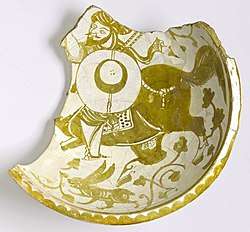
Unlike western European governments of the era, advancement in Fatimid state offices was more meritocratic than hereditary. Members of other branches of Islam, like the Sunnis, were just as likely to be appointed to government posts as Shiites. Tolerance was extended to non-Muslims, such as Christians and Jews,[38] who occupied high levels in government based on ability, and this policy of tolerance ensured the flow of money from non-Muslims in order to finance the Caliphs' large army of Mamluks brought in from Circassia by Genoese merchants. There were exceptions to this general attitude of tolerance, however, most notably by Al-Hakim bi-Amr Allah, though this has been highly debated, with Al-Hakim's reputation among medieval Muslim historians conflated with his role in the Druze faith.[38]
The Fatimids were also known for their exquisite arts. A type of ceramic, lustreware, was prevalent during the Fatimid period. Glassware and metalworking was also popular. Many traces of Fatimid architecture exist in Cairo today; prominent examples include the Al-Azhar University and the Al-Hakim Mosque. The madrasa is one of the relics of the Fatimid era in Egypt, descended from Fatimah, daughter of Muhammad. Fatimah was called Az-Zahra (the brilliant), and the madrasa was named in her honour.[55] The Fatimid palace in Cairo had two parts. It stood in the Khan el-Khalili area at Bayn El-Qasryn street.[56]
Military system
The Fatimid military was based largely on the Kutama Berber tribesmen brought along on the march to Egypt, and they remained an important part of the military even after Tunisia began to break away.[57] After their successful establishment in Egypt, local Egyptian forces were also incorporated into the army, so the Fatimid Army were reinforced by North African soldiers from Algeria to Egypt in the Eastern North (and of succeeding dynasties as well).
A fundamental change occurred when the Fatimid Caliphate attempted to push into Syria in the latter half of the 10th century. The Fatimids were faced with the now Turkish-dominated forces of the Abbasid Caliphate and began to realize the limits of their current military. Thus during the reign of Abu Mansur Nizar al-Aziz Billah and Al-Hakim bi-Amr Allah, the Caliph began incorporating armies of Turks and, later, black Africans (even later, other groups such as Armenians were also used).[58] The army units were generally separated along ethnic lines: the Berbers were usually the light cavalry and foot skirmishers, while the Turks were the horse archers or heavy cavalry (known as Mamluks). The black Africans, Syrians, and Arabs generally acted as the heavy infantry and foot archers. This ethnic-based army system, along with the partial slave status of many of the imported ethnic fighters, would remain fundamentally unchanged in Egypt for many centuries after the fall of the Fatimid Caliphate.
The Fatimids focused their military on the defence of the empire as threats presented, which they were able to repel. In the mid-10th century, the Byzantine Empire was ruled by Nikephoros II Phokas, who had destroyed the Muslim Emirate of Chandax in 961 and conquered Tartus, Al-Masaisah, 'Ain Zarbah, among other areas, gaining complete control of Iraq and the Syrian borders, and earning the sobriquet "The Pale Death of the Saracens". With the Fatimids, however, he proved less successful. After renouncing his payments of tribute to the Fatimid caliphs, he sent an expedition to Sicily, but was forced by defeats on land and sea to evacuate the island completely. In 967, he made peace with the Fatimids and turned to defend himself against their common enemy, Otto I, who had proclaimed himself Roman Emperor and had attacked Byzantine possessions in Italy.
Legacy
After Al-Mustansir Billah, his sons Nizar and Al-Musta'li both claimed the right to rule, leading to a split into the Nizari and Musta'li factions respectively. Nizar's successors eventually came to be known as the Aga Khan, while Musta'li's followers eventually came to be called the Dawoodi bohra (Syedna Aali Qadr Mufaddal Saifuddin (Arabic: سيّدنا عـالي قـدر مُـفـضّـل سـيـفُ ٱلـدّين) is the 53rd and current Da'i al-Mutlaq[1] of the Dawoodi Bohras)
The Fatimid dynasty continued and flourished under Al-Musta'li until Al-Amir bi-Ahkami'l-Lah's death in 1130. Leadership was then contested between At-Tayyib Abu'l-Qasim, Al-Amir's two-year-old son, and Al-Hafiz, Al-Amir's cousin whose supporters (Hafizi) claimed Al-Amir died without an heir. The supporters of At-Tayyib became the Tayyibi Isma'ilis. At-Tayyib's claim to the imamate was endorsed by Arwa al-Sulayhi, Queen of Yemen. In 1084, Al-Mustansir had Arwa designated a hujjah (a holy, pious lady), the highest rank in the Yemeni Da'wah. Under Arwa, the Da'i al-Balagh (the imam's local representative) Lamak ibn Malik and then Yahya ibn Lamak worked for the cause of the Fatimids. After At-Tayyib's disappearance, Arwa named Dhu'ayb bin Musa the first Da'i al-Mutlaq with full authority over Tayyibi religious matters. Tayyibi Isma'ili missionaries (in about 1067 AD (460 AH)) spread their religion to India,[59][60] leading to the development of various Isma'ili communities, most notably the Alavi, Dawoodi, and Sulaymani Bohras. Syedi Nuruddin went to Dongaon to look after southern India and Syedi Fakhruddin went to East Rajasthan.[61][62]
See also
- List of Shia Islamic dynasties
Notes
References
- Hathaway, Jane (2012). A Tale of Two Factions: Myth, Memory, and Identity in Ottoman Egypt and Yemen. SUNY Press. p. 97. ISBN 9780791486108.
- Turchin, Peter; Adams, Jonathan M.; Hall, Thomas D (December 2006). "East-West Orientation of Historical Empires". Journal of World-Systems Research. 12 (2): 222. ISSN 1076-156X. Retrieved 12 September 2016.
- Rein Taagepera (September 1997). "Expansion and Contraction Patterns of Large Polities: Context for Russia". International Studies Quarterly. 41 (3): 495. doi:10.1111/0020-8833.00053. JSTOR 2600793.
- Ilahiane, Hsain (2004). Ethnicities, Community Making, and Agrarian Change: The Political Ecology of a Moroccan Oasis. University Press of America. p. 43. ISBN 978-0-7618-2876-1.
- Julia Ashtiany; T. M. Johnstone; J. D. Latham; R. B. Serjeant; G. Rex Smith, eds. (30 March 1990). Abbasid Belles Lettres. Cambridge University Press. p. 13. ISBN 978-0-521-24016-1.
- Wintle, Justin (May 2003). History of Islam. London: Rough Guides Ltd. pp. 136–7. ISBN 978-1-84353-018-3.
- Pollard;Rosenberg;Tignor, Elizabeth;Clifford;Robert (2011). Worlds together Worlds Apart. New York, New York: Norton. p. 313. ISBN 9780393918472.CS1 maint: multiple names: authors list (link)
- Baer, Eva (1983). Metalwork in Medieval Islamic Art. SUNY Press. p. xxiii. ISBN 9780791495575.
In the course of the later eleventh and twelfth century, however, the Fatimid caliphate declined rapidly, and in 1171 the country was invaded by Ṣalāḥ ad-Dīn, the founder of the Ayyubid dynasty. He restored Egypt as a political power, reincorporated it in the Abbasid caliphate and established Ayyubid suzerainty not only over Egypt and Syria but, as mentioned above, temporarily over northern Mesopotamia as well.
- Canard 1965, p. 850.
- Madelung 1971, pp. 1163–1164, 1167.
- Madelung 1986, pp. 1230–1234.
- Madelung 1986, pp. 1235–1237.
- Brett 2017, p. 18.
- Daftary 2007, p. 89.
- Daftary 2007, pp. 88–89.
- Halm 1991, pp. 27–28.
- Daftary 2007, pp. 89–90.
- Daftary 2007, pp. 90–96.
- Halm 1991, pp. 29–30.
- Halm 1991, pp. 16–20.
- Halm 1991, pp. 22–24.
- Daftary 2007, p. 100.
- Daftary 2007, p. 108.
- Madelung 1978, p. 198.
- Halm 1991, p. 47.
- Daftary 2007, pp. 108–110.
- Canard 1965, p. 852.
- Halm 2014.
- Halm 1991, pp. 63–64.
- Canard 1965, pp. 850–851.
- Daftary 2007, pp. 100–107.
- Daftary 2007, pp. 122–123.
- Daftary 2007, p. 143.
- Lev 1995, pp. 194–195.
- Canard 1965, p. 853.
- Canard 1965, pp. 852–853.
- Beeson, Irene (September–October 1969). "Cairo, a Millennial". Saudi Aramco World: 24, 26–30. Archived from the original on 30 September 2007. Retrieved 9 August 2007.
- Kenneth M. Setton; Marshall W. Baldwin (1969). A History of the Crusades: The First Hundred Years. Univ of Wisconsin Press. p. 104. ISBN 978-0-299-04834-1. Retrieved 26 February 2019.
The Fatimid caliphate at its height included Egypt, Syria, the Hejaz, the Yemen, North Africa, and Sicily, and commanded the allegiance of countless followers in the eastern lands still subject to the Abbasids of Baghdad.
- Daftary, Farhad (20 September 2007). The Isma'ilis: Their History and Doctrines. ISBN 9781139465786.
- Allan Trawinski (25 June 2017). The Clash of Civilizations. Page Publishing Inc. p. 185. ISBN 978-1-63568-712-5. Retrieved 26 February 2019.
Originally based in Tunisia, the Fatimid Dynasty extended their rule across the Mediterranean coast of Africa and ultimately made Egypt the center of their caliphate. At its height, in addition to Egypt, the caliphate included varying areas of the Maghreb, Sicily, the Levant, and the Hijaz.
- Cortese, Delia (January 2015). "The Nile: Its Role in the Fortunes and Misfortunes of the Fatimid Dynasty During its Rule of Egypt (969-1171)" (PDF). History Compass. 13 (1): 20–29. doi:10.1111/hic3.12210. ISSN 1478-0542.
- Cambridge history of Egypt vol 1 page 155
- al Juyushi: A Vision of the Fatemiyeen. Graphico Printing Ltd. 2002. ISBN 978-0953927012.
- "Masjid al-Juyushi". Archnet.org. Archived from the original on 5 January 2014. Retrieved 25 May 2013.
- Amin Maalouf (1984). The Crusades Through Arab Eyes. Al Saqi Books. pp. 160–170. ISBN 978-0-8052-0898-6.
- al-Mustanṣir Encyclopædia Britannica
- Wilson B. Bishai (1968). Islamic History of the Middle East: Backgrounds, Development, and Fall of the Arab Empire. Allyn and Bacon.
Nevertheless, the Seljuqs of Syria kept the Crusaders occupied for several years until the reign of the last Fatimid Caliph al-Adid (1160–1171) when, in the face of a Crusade threat, the caliph appointed a warrior of the Seljuq regime by the name of Shirkuh to be his chief minister.
- Delia Cortese and Simonetta Calderini (2006), Women and the Fatimids in the World of Islam, pp. 111-114.
- Brief History of Transfer of the Sacred Head of Hussain ibn Ali, From Damascus to Ashkelon to Qahera
- Brief History of Transfer of the Sacred Head of Husain ibn Ali, From Damascus to Ashkelon to Qahera By: Qazi Dr. Shaikh Abbas Borhany PhD (USA), NDI, Shahadat al A’alamiyyah (Najaf, Iraq), M.A., LLM (Shariah) Member, Ulama Council of Pakistan, Published in Daily News, Karachi, Pakistan on 03-1-2009.
- Talbi, M., "al-Mahdiyya", in: Encyclopaedia of Islam, Second Edition, edited by: P. Bearman, Th. Bianquis, C. E. Bosworth, E. van Donzel, W. P. Heinrichs. Consulted online on 24 April 2017
- Talbi, M., "Ṣabra or al-Manṣūriyya", in: Encyclopaedia of Islam, Second Edition, Edited by: P. Bearman, Th. Bianquis, C.E. Bosworth, E. van Donzel, W.P. Heinrichs. Consulted online on 24 April 2017
- Rogers, J.M., J. M. Rogers and J. Jomier, “al-Ḳāhira”, in: Encyclopaedia of Islam, Second Edition, Edited by: P. Bearman, Th. Bianquis, C.E. Bosworth, E. van Donzel, W.P. Heinrichs. Consulted online on 24 April 2017
- Halm, Heinz. The Fatimids and their Traditions of Learning. London: The Institute of Ismaili Studies and I.B. Tauris. 1997.
- "Cairo of the Mind". oldroads.org. 21 June 2007. Archived from the original on 12 December 2007.
- Cambridge History of Egypt, vol. 1, pg. 154.
- Cambridge History of Egypt, Vol. 1, pg. 155.
- Enthoven, R. E. (1922). The Tribes and Castes of Bombay. 1. Asian Educational Services. p. 199. ISBN 978-81-206-0630-2.
- The Bohras, By: Asgharali Engineer, Vikas Pub. House, p.109,101
- Blank, Jonah (15 April 2001). Mullahs on the Mainframe. p. 139. ISBN 0226056767.
- Daftary, Farhad (24 April 1992). The Isma'ilis: Their History and Doctrines. p. 299. ISBN 0521429749.
Sources
- Brett, Michael (2001). The Rise of the Fatimids: The World of the Mediterranean and the Middle East in the Fourth Century of the Hijra, Tenth Century CE. The Medieval Mediterranean. 30. Leiden: BRILL. ISBN 978-9004117419.
- Brett, Michael (2017). The Fatimid Empire. The Edinburgh History of the Islamic Empires. Edinburgh: Edinburgh University Press. ISBN 978-0-7486-4076-8.CS1 maint: ref=harv (link)
- Canard, Marius (1965). "Fāṭimids". In Lewis, B.; Pellat, Ch. & Schacht, J. (eds.). The Encyclopaedia of Islam, New Edition, Volume II: C–G. Leiden: E. J. Brill. pp. 850–862. OCLC 495469475.
- Cortese, Delia, "Fatimids", in Muhammad in History, Thought, and Culture: An Encyclopedia of the Prophet of God (2 vols.), Edited by C. Fitzpatrick and A. Walker, Santa Barbara, ABC-CLIO, 2014, Vol I, pp. 187–191.
- Daftary, Farhad (2007). The Ismāʿı̄lı̄s: Their History and Doctrines (Second ed.). Cambridge: Cambridge University Press. ISBN 978-0-521-61636-2.
- Daftary, Farhad (1999). "FATIMIDS". Encyclopaedia Iranica, Vol. IX, Fasc. 4. pp. 423–426.
- Halm, Heinz (1991). Das Reich des Mahdi: Der Aufstieg der Fatimiden [The Empire of the Mahdi: The Rise of the Fatimids] (in German). Munich: C. H. Beck. ISBN 978-3-406-35497-7.
- Halm, Heinz (2014). "Fāṭimids". In Fleet, Kate; Krämer, Gudrun; Matringe, Denis; Nawas, John; Rowson, Everett (eds.). Encyclopaedia of Islam, THREE. Brill Online. ISSN 1873-9830.
- Kennedy, Hugh (2004). The Prophet and the Age of the Caliphates: The Islamic Near East from the 6th to the 11th Century (Second ed.). Harlow: Longman. ISBN 978-0-582-40525-7.
- Lev, Yaacov (1987). "Army, Regime, and Society in Fatimid Egypt, 358–487/968–1094". International Journal of Middle East Studies. 19 (3): 337–365. doi:10.1017/S0020743800056762. JSTOR 163658. S2CID 162310414.CS1 maint: ref=harv (link)
- Lev, Yaacov (1995). "The Fatimids and Byzantium, 10th–12th Centuries". Graeco-Arabica. 6: 190–208. OCLC 183390203.
- Madelung, W. (1971). "Imāma". In Lewis, B.; Ménage, V. L.; Pellat, Ch. & Schacht, J. (eds.). The Encyclopaedia of Islam, New Edition, Volume III: H–Iram. Leiden: E. J. Brill. pp. 1163–1169. OCLC 495469525.
- Madelung, Wilferd (1978). "Ismāʿīliyya". In van Donzel, E.; Lewis, B.; Pellat, Ch. & Bosworth, C. E. (eds.). The Encyclopaedia of Islam, New Edition, Volume IV: Iran–Kha. Leiden: E. J. Brill. pp. 198–206. OCLC 758278456.
- Madelung, W. (1986). "al-Mahdī". In Bosworth, C. E.; van Donzel, E.; Lewis, B. & Pellat, Ch. (eds.). The Encyclopaedia of Islam, New Edition, Volume V: Khe–Mahi. Leiden: E. J. Brill. pp. 1230–1238. ISBN 90-04-07819-3.
- Sanders, Paula (1994). Ritual, Politics, and the City in Fatimid Cairo. Albany, New York: State University of New York Press. ISBN 0-7914-1781-6.
- Walker, Paul E. (2002). Exploring an Islamic Empire: Fatimid History and its Sources. London: I.B. Tauris. ISBN 9781860646928.CS1 maint: ref=harv (link)
- Walker, Paul E. (2018). "Fāṭimids". In Madelung, Wilferd; Daftary, Farhad (eds.). Encyclopaedia Islamica Online. Brill Online. ISSN 1875-9831.
External links
| Wikimedia Commons has media related to Fatimid Caliphate. |
- Fatimids entry in the Encyclopaedia of the Orient.
- The Institute of Ismaili Studies, London.
- The Shia Fatimid Dynasty in Egypt
— Imperial house — Fatimid dynasty | ||
| Preceded by Aghlabid dynasty |
Ruling house of Ifriqiya 909–972 |
Succeeded by Zirid dynasty as Fatimid clients |
| Preceded by Ikhshidid dynasty |
Ruling house of Egypt 969–1171 |
Succeeded by Ayyubid dynasty |
| Titles in pretence | ||
|---|---|---|
| Preceded by Abbasid dynasty |
Caliphate dynasty 909–1171 With: Abbasid dynasty, Umayyad dynasty |
Succeeded by Abbasid dynasty |


